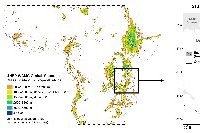| |
RARE PLANTS GALLERY
- The Eastern Arc Mountains study region in Tanzania and Kenya, consisting of 13 distinct ranges (a.k.a. blocs). Adjacent highlands have different geological substrates and have climatic regimes influenced more by the Great African Lakes or the intertropical convergence (a band of thunderstorms that circle the globe near the equator) than by the Indian Ocean. Credit: Phil Platts.
- View from the forest floor, Kanga Forest Reserve, Nguru Mountains. Line graph illustrates that the more endemic species that are known at a site, the less likely those species’ climatic requirements are to be lost from the respective mountain blocs by the end of the century. Flow chart explains the two-step downscaling procedure used for obtaining regionally focussed, high-resolution climate scenarios in East Africa. Credit: Phil Platts and Jemma Finch.
- Psychotria megalopus Verdc. (Rubiaceae), Nawenge Forest Reserve, Mahenge Mountains, R. Gereau 6874. This species is endemic to the Eastern Arc Mountains (Uluguru, Udzungwa and Mahenge Mountains). Credit: C. Davidson, copyright www.floraoftheworld.org, 2008.
- Begonia poculifera Hook. f. (Begoniaceae), Nawenge Forest Reserve, Mahenge Mountains, R. Gereau 6890. This species is mostly distributed in forests of West and Central Africa, but also occurs in the Eastern Arc Mountains – evidence of an ancient pan-African forest belt. Credit: C. Davidson, copyright www.floraoftheworld.orgcom, 2008.
- View from the one of the ‘sky islands’ of the Eastern Arc: the Uluguru Mountains. Credit: Rob Marchant.
- Morning mists persist in Image Forest Valley, Udzungwa Mountains. Such local topographic influences may be important in maintaining local ecosystem stability during periods of broader-scale climatic change. Credit: Jemma Finch.
- Moss-covered trees in the Uluguru Mountains intercept moisture carried on Indian Ocean trade winds. Credit: Rob Marchant.
- Watercolor of Streptocarpus albus (E.A. Bruce) I. Darbysh. (Gesneriaceae), endemic to the Uluguru Mountains. Artwork by Riziki Kateya, a Tanzanian botanical artist, with kind permission of Sarah Watkins. Thanks to Colin Watkins for providing the image.
- Watercolor of Impatiens ulugurensis Warb. (Balsaminaceae), endemic to the Uluguru Mountains. Common name: Busy Lizzie. Artwork by Riziki Kateya, a Tanzanian botanical artist trained at the Royal Botanic Gardens, Kew. Thanks to Colin Watkins for providing the image.
TOP
|
|









